UNIFESP’S ACCESSIBILITY PORTAL: INCLUSIVE AND OPEN DESIGN TO SUPPORT INCLUSION IN HIGHER EDUCATION
By Leandro Key Higuchi Yanaze, Maria da Conceição dos Santos, Cícera Aparecida Lima Malheiro,
We are delighted to present the Accessibility Portal at the University Federal of São Paulo (Unifesp) as an important tool to guide the implementation of our recently established Accessibility and Inclusion Policy. We will briefly highlight a few key elements that underlie the philosophy of our inclusion practices in higher education. We will then describe our initial implementation with reference to a group of students with disability[1].
Education: key element to promote social justice
Education is key for promoting social justice and participation for all citizens, without discrimination of any form. It is a fundamental human right and an essential condition for all individuals to fully develop their potential and effectively participate in society (UN, 2018).
Worldwide, persons with disabilities belong to a vulnerable population who experience discrimination, stigma and increased risk of social isolation.
Globally, access to higher education for many students with disabilities is only a recent possibility. Fortunately, change is underway through policy formulation and implementation aimed at this segment of society (CAIADO, 2013; TIMMERMAN; MULVIHILL, 2015; YSSEL et al, 2016; MELO; MARTINS, 2016; LINDSAY et al, 2018).
Identifying disability as a social marker of human diversity allows us to understand the process of exclusion as a complex sociohistorical phenomenon in general society and in the field of higher education.
The Disability and Development Report (UN, 2018) in its analysis of the 2030 Agenda for Sustainable Development (SDGs-UN) establishes a disability theme as transversal to the whole set of objectives and specifically to education. The Report further indicates the importance of accessibility in order for an environment to be inclusive and sensitive to the diversity of human functioning.
According to this document, available evidence shows that persons with disabilities are less likely to attend school, complete primary or secondary education and become literate, thus pointing to an urgent need to improve access to education for children and youth with disabilities. Disability puts young people at greater risk of social exclusion and poverty because of limited opportunity to participate in education and the world of work.
Convention on the Rights of Persons with Disabilities: a new milestone
As a fruitful result of historical struggles in the political and academic arena, the Social Disability Model (OLIVER, 2013) has advanced our understanding of the complexity of disability, culminating in — among other important documents — the Convention on the Rights of Persons with Disabilities (CONVENTION ON THE RIGHTS …, 2006) launched by the United Nations.
This Convention constitutes a new milestone in the recognition of struggles in defence of the rights of persons with disabilities, as well as for legislators and social policymakers informing institutional actors, whether in the public or private sector, about their responsibilities when formulating policies, services, and products to ensure equal access for all citizens despite any limitations on human functioning (FOUGEYROLLAS et al., 2019).
Brazil, where we are located, is a signatory of the Convention, and even though students with disabilities have their rights to education guaranteed in several national legal documents prior to the UN Convention, routine instructional practices remain inconsistent affecting access and retention of young persons with disability in secondary and higher education (ROCHA; BRUNELLO; SOUZA, 2018; CAIADO, 2013).
The presence of students with disabilities calls out the university to review preconceptions about disability and transform curriculum and instructional practices to be as flexible as necessary to ensure the rights of education.
In Brazil, there are important legal instruments for strengthening inclusive education and special admissions quotas for minority groups such as persons with disability: National Policy from the Perspective of Inclusive Education (BRASIL, 2008), the National Student Assistance Program (PNAES), the Brazilian Inclusion Law (BRASIL, 2015) to name a few.
However, a crucial point we want to highlight about Brazilians’ civil rights of access and retention in higher education is to recognize that special education and inclusion approaches demand investments and efforts to accomplish institutional and cultural change. Without such investments, the implementation of inclusive educational practices from the perspective of human rights and diverse human functioning cannot be achieved.
To enter a federal university all candidates must take the National High School Exam (ENEM) and, according to their score, they may apply to many universities, to a graduation course of their choice. The candidate, being a person with disabilities (motor, visual, hearing, intellectual or multiple) will compete for specific vacancies, as provided for in the Law of Quotas (BRASIL, 2016) mentioned above.
Along this path, we still experience intense challenges not only in the institutionalization of policies that guarantee accessibility to students with disabilities in higher education but also in the cultural change of the university to guarantee their retention and participation in the daily life at the university and the creation of a curriculum accessible to all (MALHEIRO e SCHLÜNZEN JUNIOR, 2019).
Covid19 Pandemic: one more challenging layer for inclusion policies
The world is undergoing an intense transformation due to the Covid19 pandemic. Social isolation along with access to vaccine thus far have been effective strategies for controlling the SARS-Cov-2 virus. This pandemic has necessitated higher education institutions in Brazil to review their institutional policies and pedagogic strategies to ensure continuity in teaching and learning. At the same time, universities are challenged to respect the principles of equality and equity with regard to computer and internet access.
Recent studies have shown that the main barriers to the retention of students with disabilities in higher education refer to the lack of pedagogical and architectural access and the absence of adequate institutional support mechanisms at normative, administrative, and pedagogical levels that equally suit their specific educational needs. Another barrier is related to the unpreparedness of teaching personnel along with their lack of knowledge concerning the needs of students with disabilities (MARSHAK et al., 2010; TIMMERMAN; MULVIHILL, 2015; YSSEL et al, 2016; LINDSAY et al, 2018; MARTINS et al., 2018).
In the context of the educational inclusion paradigm, disability studies in education have presented the perspective of Universal Design for Learning (UDL) – an analytical framework – as a possibility for the process of developing structured educational environments for minimizing and eliminating barriers in schooling. for all persons, including those with disabilities (BOCK et al., 2018 p.144).
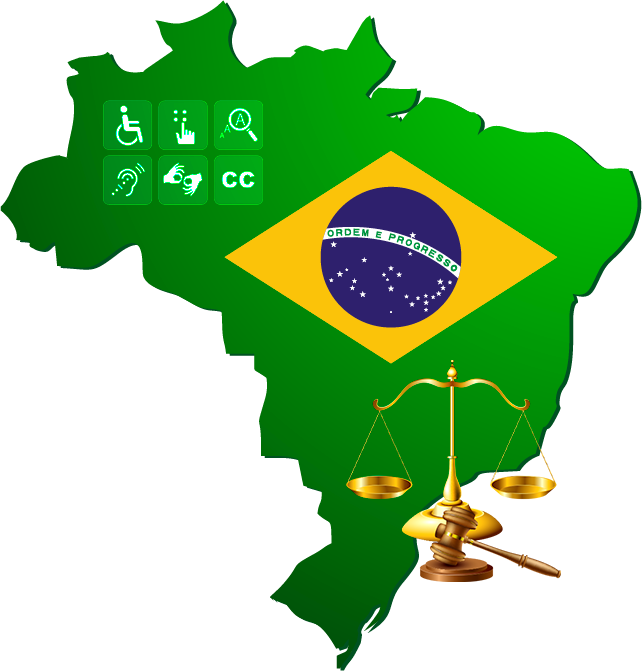
Figure 1: Brazil map, symbol of justice and accessibility icons
Federal University of São Paulo – a single Accessibility and Inclusion Policy in a multicampus University
The Federal University of São Paulo (Unifesp), originally created in 1933, in the city of São Paulo, started as a medical school, later added a nursing course. In the 1990s it became a university already having a few other courses, all related to the health professions.
In the 2000s, a new federal governmental educational policy was adopted in Brazil aiming to democratize access to a public and free higher education raising the education access to a larger number of citizens of this continental country.
In 2004 Unifesp expanded from a health professionals university to offer courses in other areas of knowledge such as human sciences. To do so, it turns into a multicampus university, moving from the city of São Paulo to other municipalities in the state of São Paulo, in the southeastern region of the country.
Unifesp currently occupies seven campuses, each having a local board linked to a central administration. Two of them are in the city of São Paulo, and the other five are distributed in the cities of Santos, Osasco, Guarulhos, Diadema and São José dos Campos.
Located in the coastal city of Santos, the Campus Baixada Santista has two institutes: The Institute of Health and Society (ISS) [2] and the Institute of the Sea (IMar)[3]. Both have undergraduate and graduate courses, with academic units located at various addresses in the city carrying out research and extensive activities to meet the demands of the population and municipality related to health, social, and environmental issues.

Figure 2: Unifesp’s campuses in the state of São Paulo, Brazil
The Accessibility and Inclusion Policy of Unifesp was recently approved by the University Council in November 2018. Thus, the Accessibility and Inclusion Center of this campus (NAI-BS) is responsible for the students at both institutes; ISS and IMAR.
As a means of achieving its goals, the policy centrally created a Technical Chamber for Accessibility and Inclusion (CTAI) linked to the central university administration, and Accessibility and Inclusion Centers (NAI) locally at each of the seven campuses.
The Central Chamber and the local Centers together with all the other administrative instances of the university constitute the Accessibility and Inclusion Network.
Thus, to work as an Accessibility Network demands that all the social actors of the university dialogue on the perspective of human rights, assuming the contemporary concept of disability stance as part of human diversity. The Unifesp’s Accessibility Network stands for the prerogative of respect for the singularities of students with disabilities in a sensitive understanding of their needs that in turn require the promotion of accessibility.
The Center of Accessibility and Inclusion of the Campus Baixada Santista
In the year of 2020, due to the COVID19 pandemic, in-person classes and administrative activities at the Unifesp on all campuses were suspended. Concerned with identifying facilitators and barriers to implement remote online teaching, the Dean of Student Affairs carried out a mapping of all Unifesp students. The goal was to determine who among students have access to digital technologies (computer, etc) and how they are able to communicate (connectivity).
The result of this mapping for the Campus Baixada Santista pointed out that of the total of 1256 students who answered the Pro-Rectory of Students Affairs questionnaire, 17 of them answered “yes” to the question “Do you have physical, hearing, visual or cognitive disabilities that would hinder your participation in remote teaching/learning? “
Based on this information, the NAI-BS compared its own records from 2016 to the present year and a new questionnaire was sent via Google forms in order to collect detailed information about barriers to remote learning and disability status, totalling 41 students
Graph 1 shows the distribution of students who declared some condition. Among them some who fit the so-called invisible disabilities (dyslexia, autism spectrum disorder, etc.), and who are the target population of special education, but were not identified by the NAI until then.
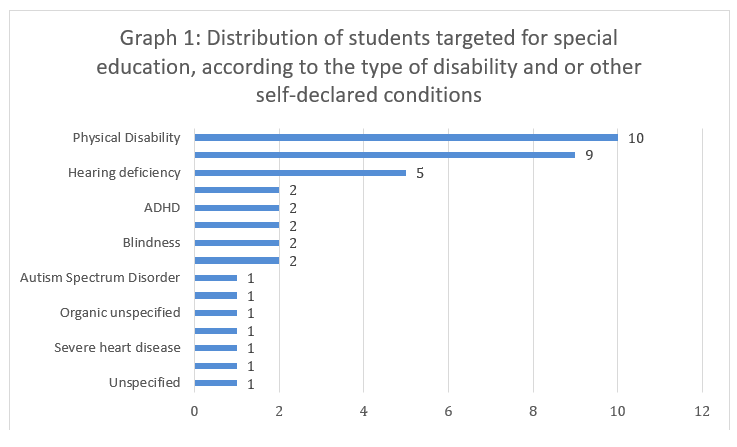
The active search through electronic questionnaires allowed the free expression of students in relation to their needs. This has revealed the importance of obtaining individual information from each student and do not rely only on the numbers already highlighted by those who enter under the quota law and are automatically identified by the occasion of the enrollment.
Graph 2, below, shows the distribution of the total number of students enrolled in the courses of the two Institutes on the Campus Baixada Santista, according to the type of admission.
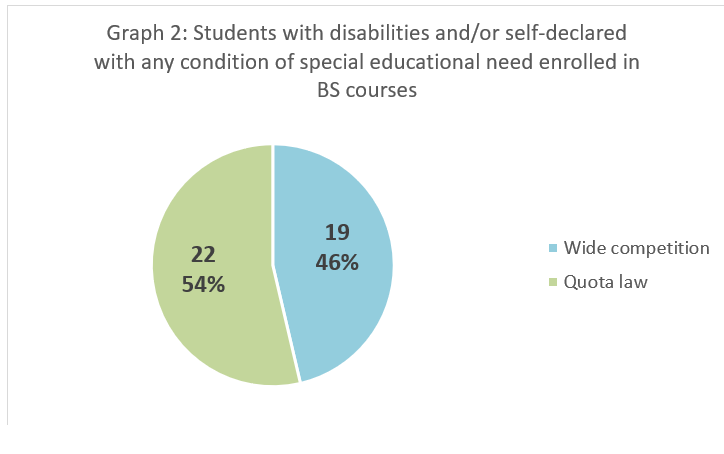
From the group of students, according to the year of entry (Graph 3), the year 2020 concentrates the largest number of students, but among them only four entered by the quota law, 13 of which are self-declared.

It is worth mentioning here that of the total of 22 students enrolled by the Quota Law (Graph 1), four of them receive regular and individualized attention from the NAI-BS since the beginning related to the needs of pedagogical accessibility, doing so by intermediating the dialogue with the course coordination and conscientization of the teaching staff, namely: one student with hearing impairment, two with blindness and one with severe cardiopulmonary impairment, all of whom enrolled before year 2020.
Of the rest, nine of them have mild motor disabilities and have no special needs, and five students from the start preferred not to be identified as a student with disabilities, declaring that they do not need any specific support.
Four students, enrolled between the years 2016 and 2017 (two with mild intellectual disabilities and two with low vision) declared demands for specific support (longer exam time, regulation of classroom lights, increased font size for reading), information that was passed on directly to course coordinators.
The academic calendar of 2020 for the new students coincided with the suspension of all presential classes and any academic activities as a measure of biosafety due to the COVID19 pandemic. Regarding them, the NAI-BS provided notification to the course’s coordinators, based on that recent mapping, including the set of self-declared students, so that the coordinator himself and his faculty can gradually go on welcoming their students, even that remotely, and trigger the NAI-BS as needed.
Finally, in Graph 4, below, the distribution of the total of 41 students according to the graduation course is shown:
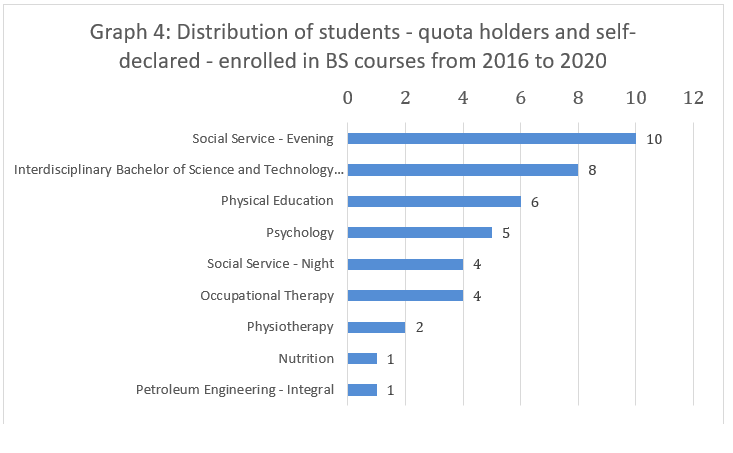
Social Work has the largest number of students with disabilities and/or self-declared students with special educational needs. The data of the present mapping does not allow us to make great conclusions about the option for professions, but could we ask the question if the choice of profession would be related to the very experiences of social inequalities along the schooling trajectory?
Promoting inclusion on a daily basis: advances and challenges.
It is necessary to emphasize the complexity of teamwork, too large sometimes, diverse in its views and conceptions – in positivist nature by some and in a more humanistic nature by others – about disability, human functioning, inclusion. Due to this, NAI-BS has elected some strategic actions at the macro and meso levels.
To name a few, at a micro level we adopted the accommodation principle when proposing singular solutions to a specific need of a specific student. It takes the ability to negotiate dialogically with the student, course coordinators and teachers as well as other sections involved to eliminate a disabling situation (Marshak, Raeke Ferrell & Dugan, 2010, Timmerman & Mulvihill, 2015, Yssel & Beilke, 2016, Lindsay, Cagliostro & Carafa, 2016).
We have also begun studying the framework of universal design for learning (UDL) recognizing that it is an important theoretical reference to promote inclusion, retention, and academic success of students with disabilities (Bock, Gesser & Nuernberg, 2018).
Another fruitful strategy recently started is to invest in peer support. To do so, we recently performed an online workshop with monitors (students volunteers) aiming firstly to pose an open discussion group about disabling situations in remote classes and secondly to train them how to identify digital and attitudinal barriers to pedagogic accessibility. For example: Is the closed caption tool being used in online classes? The audio description principles have been considered when producing teaching material? How to do and what are the main elements of audio description?
Unifesp Accessibility Portal
Although the portal is a webspace and includes the main features provided for a website (texts, images, animations, information), it also provides a communication channel (forum) for all stakeholders to participate in a Virtual Learning Community encouraging knowledge sharing.
The Unifesp Accessibility Portal gathers resources that have been mapped and developed and are made available on its pages and shared in the virtual learning community. Its actions provide for internal and external collaboration to contribute to the inclusion in higher education inside and outside Unifes. The portal provides visibility to the actions carried out by the Technical Chamber of Accessibility and Inclusion (CTAI) and the Unifesp Accessibility and Inclusion Centers (NAI) and it fosters inter-institutional partnerships, national and international, for the development of practical actions and research that contribute to inclusion in higher education. In this way, the established objectives are to contribute:
a) in the dissemination and sharing of actions, training experiences and resources, which aim to promote the reduction of architectural, pedagogical, attitudinal, communication and information barriers by making students, teachers, and educational administrative technicians aware of inclusive and accessibility processes and resources in Higher Education.
b) in the development of institutional actions and policies for Inclusion and Accessibility in Higher Education, committed to the educational and social transformation for the full exercise of citizenship and the strengthening of democracy and human rights.
c) in the participation, collaboration, and visibility of accessibility actions within the institution, nationally and internationally, articulating, and congregating extension projects through courses, events and services related to inclusion and accessibility, as well as promoting the development of research in the area.
Unifesp’s Accessibility Portal also aims to promote “recognition, respect for difference and appreciation of human diversity and which requires awareness, information and training for teachers, students and the entire community inside and outside the academic universe”. Thus, one of the fundamental pillars of the portal is to disseminate the culture of inclusion in higher education through teaching materials on the dimensions of accessibility, Universal Design for Learning, conditions, and disabilities. This educational role is well aligned with Sustainable Development Goal 4 (ODS4), which is scoped to “Ensure inclusive and equitable quality education and promote lifelong learning opportunities for all” (https://sdgs.un.org/goals), because it intends to provide open educational resources through documents, e-books, articles, handouts, videos and courses available for free, open and accessible.
The portal assimilates the pillars of open education as a space that aggregates open educational resources, contributing to the dissemination of the culture of accessibility in the institution and in society. The intention is to provide such materials on inclusive education, accessibility, and issues of persons with disabilities free of charge.
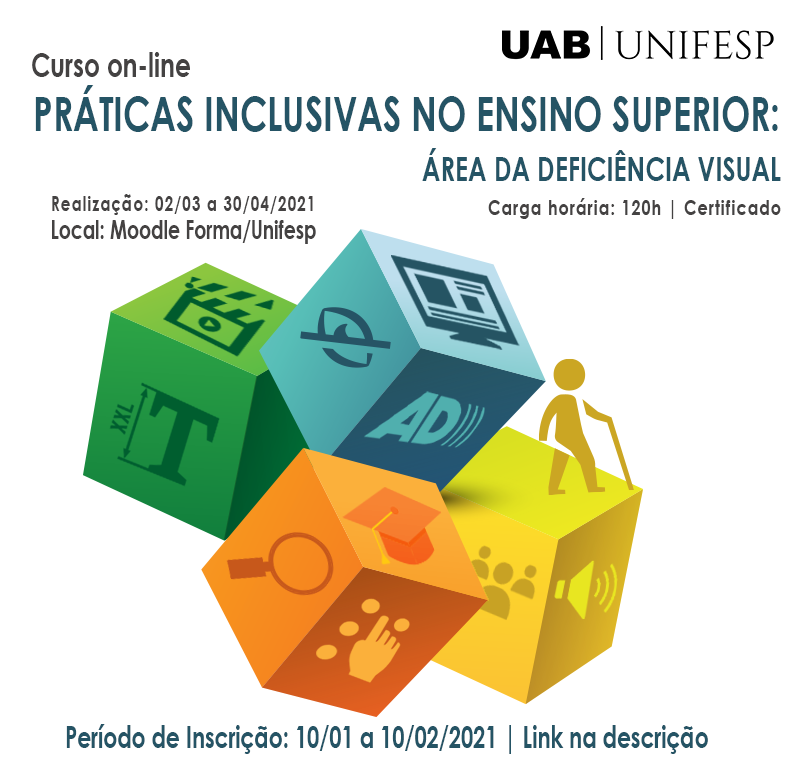
Figure 3 – Course example – Course “Inclusive practices in Higher Education: area of visual impairment”
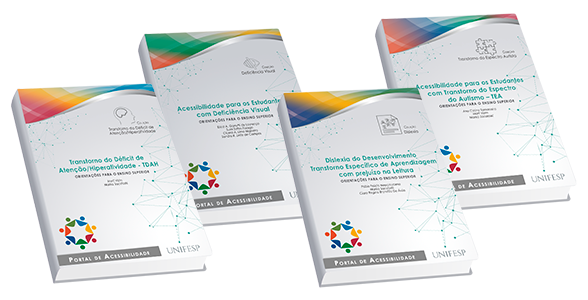
Figure 4 – E-books on various types of disabilities
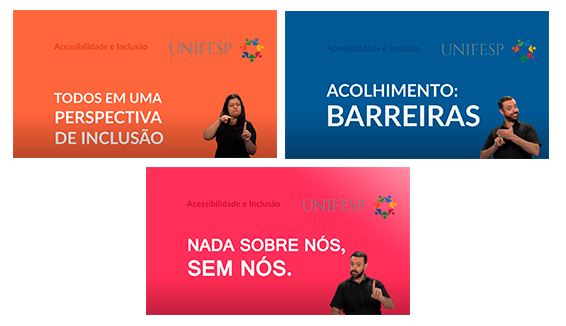
Figure 5: Access the Channel here: https://www.youtube.com/channel/UCImf7LlJvgFouIkfiID3vxA
Among the varieties of practices and meanings related to the Virtual Learning Community (VLC) proposed by Coll (2003 apud LIMA; GUIMARÃES 2018 p. 123), the proposal of this VLC within the scope of the Accessibility Portal corresponds to groups of persons who share spaces non-formal educational, designated under various dimensions of intentions, and involving the learning of skills and/or the development of potentialities; learning and exercising practices that enable subjects to organize themselves with community goals, aimed at solving everyday collective problems, in this case, the inclusion of students with disabilities, high skills/giftedness and autism spectrum disorder.
Access further information here: https://acessibilidade.unifesp.br/forum-de-acessibilidade.
According to the Brazilian Inclusion Law (Law No. 13,146 / 2015) accessibility is considered the condition for using, safely and autonomously, fully or assisted, spaces, furniture and urban equipment, buildings, transport services, devices, and systems and means of communication and information used by persons with disabilities or reduced mobility (BRASIL, 2015).
The concept of accessibility has been expanded by the literature, associated with the commitment to improve the quality of life of all persons. In this process, it is believed to be essential to consider the different dimensions of accessibility, which are part of the design and structure of the Accessibility Portal:
- ARCHITECTURAL ACCESSIBILITY considers the elimination of barriers in all physical environments, internal and external.
- COMMUNICATIONAL ACCESSIBILITY aims to overcome obstacles in all areas of communication, considered in its different forms; spoken, written, sign, sign language, digital, among others.
- METHODOLOGICAL AND CURRICULAR ACCESSIBILITY facilitates access to the syllabus offered by educational institutions, expanding teaching and learning strategies.
- INSTRUMENTAL ACCESSIBILITY allows accessibility in all instruments, utensils, resources, and equipment, used in the educational institution and in the student’s daily life, using knowledge from the field of assistive technology.
- PROGRAMMATIC ACCESSIBILITY contributes to professional and social training initiatives to combat prejudice, forms of discrimination and other attitudes that prevent or hinder access to resources and services offered by society, promoting the inclusion and equalization of opportunities.
- ATITUDINAL ACCESSIBILITY helps to extinguish all types of prejudiced attitudes that prevent the full development of the potential of the person with disabilities.
- WEB / DIGITAL ACCESSIBILITY, promoting measures so that all persons can access and use the web and digital environments with autonomy and can perceive, understand, navigate, interact and contribute to these spaces.
Final considerations
The brief experience of NAI-BS, since 2018, of implementing the Accessibility and Inclusion Policy arose from the actions developed during that period. Those experience revealed the potential and challenges of changing an institutional culture at the macro, meso and microstructural dimensions to promote inclusion in higher education for the group of students with disabilities.
As a consultative body based on the premises of inclusion, special education, and accessibility, building a team proved necessary in order to detect disabling situations and to weave a strong Accessibility Network at the university. The NAI-BS actions demanded the construction of bridges to dialogue with a diverse number of institutional actors.
We highlight as particularly important, that the university’s stakeholders must invest in all dimension of accessibility as well as promoting a sensitive cultural environment among all university personnel. It is important that a community must be able to identify specific needs of students with disabilities, not as a privilege but as the right to be respected, and avoid structural disabling situations in order to promote autonomy and empower young persons with disabilities on the rights of enjoying material and cultural goods. Interrupting the long historical path of discrimination and social exclusion of this population.
REFERENCES
ALMEIDA, J.G.de A.; FERREIRA, E.L. Sentidos da inclusão de alunos com deficiência na educação superior: olhares a partir da Universidade Federal de Juiz de Fora. Psicologia Escolar e Educacional, SP. Número Especial, p. 67-75, 2018.
BOCK, G. L. K; GESSER, M.; NUERNBERG, A. H. Desenho Universal para a Aprendizagem: a Produção Científica no Período de 2011 a 2016. Revista Brasileira de Educação Especial, Marília, v.24, n.1, p.143-160, Jan.-Mar, 2018.
BRASIL. Ministério da Educação. Secretaria de Educação Especial. Política nacional de educação especial na perspectiva da educação inclusiva. Brasília, DF: MEC, 2008.
Brasil. [Estatuto da pessoa com deficiência (2015)]. Lei brasileira de inclusão da pessoa com deficiência [recurso eletrônico]: Lei nº 13.146, de 6 de julho de 2015, que institui a Lei brasileira de inclusão da pessoa com deficiência (Estatuto da pessoa com deficiência) / Câmara dos Deputados. – Brasília: Câmara dos Deputados, Edições Câmara, 2015. – (Série legislação; n. 200)
BRASIL. Ministério da Educação. Documento orientador: Programa Incluir Acessibilidade na Educação Superior. Brasília, 2013. Disponível em: http://portal.mec.gov.br/index.php?option=com_docman&view=download&alias=13292-doc-ori-progincl&category_slug=junho-2013-pdf&Itemid=30192. Acessado em:13/03/2020.
Caiado, K.R.M. (org). Trajetórias escolares de alunos com deficiência. São Carlos: EdUFSCar, 2013, 242p.
Charles, N.; Jocelyne, F.; Anne-Louise, F.; Louise, C. La réussite académique des étudiants universitaires en situation de handicap: une étude de suivi de cohortes, La nouvelle revue – Éducation et société inclusives, v.1, n. 81, p. 219-234, 2018. DOI : 10.3917/nresi.081.0219. URL : https://www.cairn.info/revue-la-nouvelle-revue-education-et-societe-inclusives-2018-1-page-219.htm
Convenção sobre os Direitos das Pessoas com Deficiência: Protocolo Facultativo à Convenção sobre os Direitos das Pessoas com Deficiência: Decreto Legislativo nº 186, de 9 de julho de 2008: Decreto nº 6.949, de 25 de agosto de 2009. 4. ed. rev. e atual. Brasília: Secretaria de Direitos Humanos, 2012. 100p.
Fougeyrollas, P.; Boucher, N.; Edwards, G.; Grenier, Y.; Noreau, L. The Disability Creation Process Model: A Comprehensive Explanation of Disabling Situations as a Guide to Developing Policy and Service Programs. Scandinavian. Journal of Disability Research, v.21, n.1, p. 25–37, 2019.
Harpur, P. Embracing the new disability rights paradigm: the importance of the Convention on the Rights of Persons with Disabilities. Disability & Society, v.27, n. 1, p. 1-14, 2012.
Lindsay, S.; Cagliostro, E.; Carafa, G. A Systematic Review of Barriers and Facilitators of Disability Disclosure and Accommodations for Youth in Post-Secondary Education. International Journal of Disability, Development and Education, 2018. https://doi.org/10.1080/1034912X.2018.1430352
LIMA, Valéria Sperduti, GUIMARÃES, Marcelo de Paiva. Comunidades Virtuais e Aprendizagem. Mill, Daniel (org) Dicionário Crítico de Educação e Tecnologias e de Educação a Distância. Campinas: Editora Papirus. 2018.
Malheiro, C.A.L., Schulunzen Junior, K. (2019). Produção científica sobre acessibilidade no ensino superior. 2 Sumpósio Internacional de Inovação em Educação Superior (313-319). Organizado pela Universidade do Estado de Santa Catarina, Florianópolis. https://drive.google.com/file/d/1TpZJTDjYbGDPtwDYdoXJgwLzsZvCoepe/view
Marshak, V. W.; Raeke Ferrell, S.; Dugan. Exploring Barriers to College Student Use of Disability Services and Accommodations. Journal of Postsecondary Education and Disability. v. 22, n. 3, p. 152-165, 2010.
Martins, M. H.; Borges, M. L.; Gonçalves, T. Attitudes towards inclusion in higher education in a Portuguese university. International Journal of Inclusive Education, v.22, n.5, p. 527-542, 2018.
MELO, L.V. de; RICARDO, F.; Martins, M. H. Legislação para estudantes com deficiência no ensino superior no Brasil e em Portugal: algumas reflexões. Acta Scientiarum. Education, vol. 38, n. 3, julio-septiembre, 2016, pp. 259-269.
NADEAU, C.; FORTIN, J.; FOURNIER, A-L.; CAREAU, L. La réussite académique des étudiants universitaires en situation de handicap: une étude de suivi de cohortes. La nouvelle revue – education et société inclusives. vol.1, n. 81, pp. 219-234, 2018.
Oliver, M. The social model of disability: thirty years on. Disability & Society. v.28, n.7, p.1024-1026, 2013.
Rocha, E. F.; Brunelo, M. I. B., Souza, C. C. B. X. Escola para todos e as pessoas com deficiência: contribuições da terapia ocupacional. 1. Ed. São Paulo: Hucitec, 2018.
Santos, M.C. Pessoas com deficiência física, necessidades de saúde e integralidade do cuidado: análise das práticas de reabilitação no SUS [tese]. São Paulo: Faculdade de Medicina, Universidade de São Paulo; 2017.
Timmerman, L. C.; Mulvihill, T. M. Accommodations in the College Setting: The Perspectives of Students Living with Disabilities. The Qualitative Report, v. 20, n.10, p.1609-1625, 2015.
Toldrá, R. C., Santos, M. C. People with Disabilities in the Labor Market: Facilitators and Barriers. Work, v. 45, n. 4, p. 553-563, 2013.
United Nations Department of Economic and Social Affairs, 2018. Realization of the Sustainable Development Goals by, for, and with Persons with Disabilities: UN Flagship Report on Disability and Development 2018. New York, NY. Disponível em: https://social.un.org/publications/UN-Flagship-Report-Disability-Final.pdf
Yssel, N.; Pak, N.; Beilke, J. A. Door Must Be Opened: Perceptions of Students with Disabilities in Higher Education, International Journal of Disability, Development and Education, vol.63, n.3, 2016.
Mini Biographies
Prof. Leandro Key Higuchi Yanaze, Ph.D.
Is adjunct professor at Unifesp (Federal University of Sao Paulo, Brazil), in the Educational Design Technology Degree Course and researcher at Communication, Design and Digital Technologies Research Group. Holds a degree in architecture and urbanism, a master’s degree in social communication interfaces and a doctorate in electronic systems. Has experience in digital communication, games, distance learning and educational technologies. Is coordinator of projects for the development of accessible educational digital games and for accessibility and collaborates with the implementation of the Unifesp Accessibility Portal.
http://lattes.cnpq.br/3243275619679099
Prof. Maria da Conceição dos Santos, Ph.D.
Is Adjunct Professor in the Occupational Therapy Course at Institute of Health and Society, of Federal University of Sao Paulo (Unifesp), Baixada Santista campus. She currently coordinates the Accessibility and Inclusion Center of this campus and collaborates with the implementation of the Unifesp Accessibility Portal. She is a representative of the university, at the Committee for Accessibility and Disability of the Montevideo Association of Universities. She holds a master’s degree in Health Sciences and a PhD in Rehabilitation Sciences from the University of São Paulo. With a large clinical experience within the group of Person with Disabilities, in the adult life cycle, develops teaching and studies in the field of Rehabilitation and Inclusive Education in higher education, based on the theoretical studies of human rights, disabilities creation process and human functionality diversity.
http://lattes.cnpq.br/8050554599941981
Prof. Cícera Aparecida Lima Malheiro, Ph.D.
PhD in Education, Master in Special Education and Graduation in Pedagogy. Professor at Unifesp (Federal University of Sao Paulo, Brazil). Has experience and research in the areas: Technology and Education, Accessibility, Assistive Technology, Digital Games for Education, Distance Education, Educational Design and Universal Design for Learning.
http://lattes.cnpq.br/9594089174735076
Footnotes
[1] All the data and references presented here belong to two papers in pre-publication (Santos M.C et al., 2020) that will be soon published in Portuguese. The main author of both these papers is also a collaborative author of this presentation at the Include Webinar and she is also the current Coordinator of the Center of Accessibility and Inclusion of the Campus Baixada Santista.
[2] The Institute of Health and Society offers undergraduate courses in the areas of Physical Education, Physiotherapy, Nutrition, Psychology, Social Work and Occupational Therapy, and master’s and doctoral courses.
[3] The Institute of the Sea offers an undergraduate course in Marine Sciences, as well as a master’s and doctorate course.